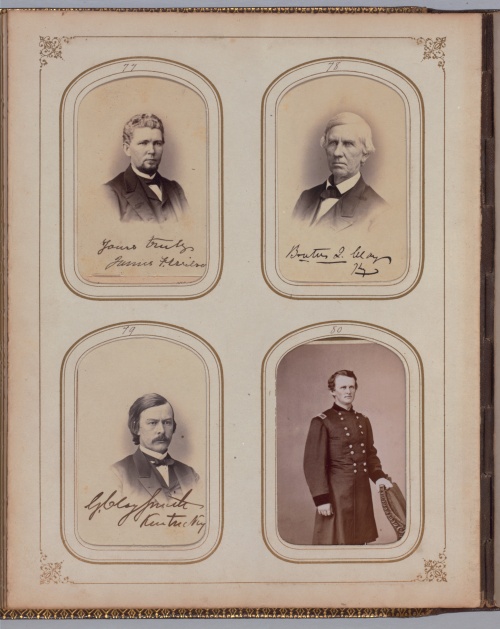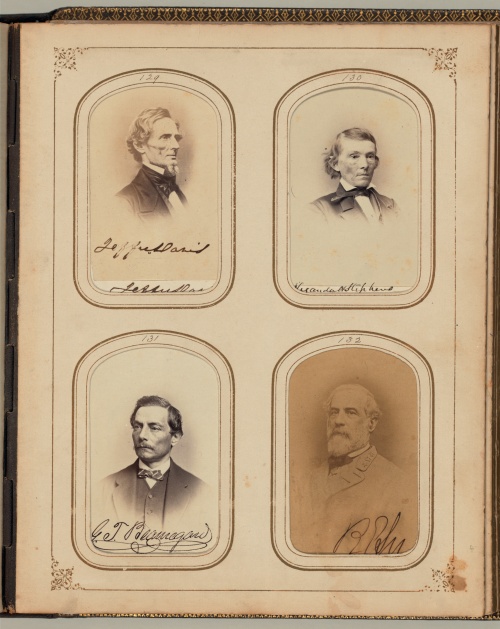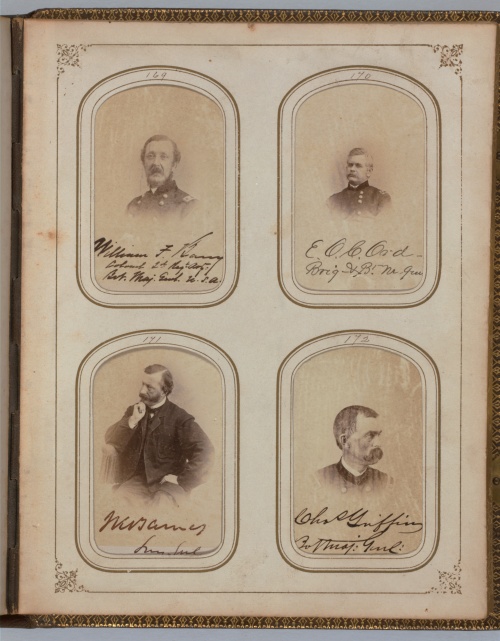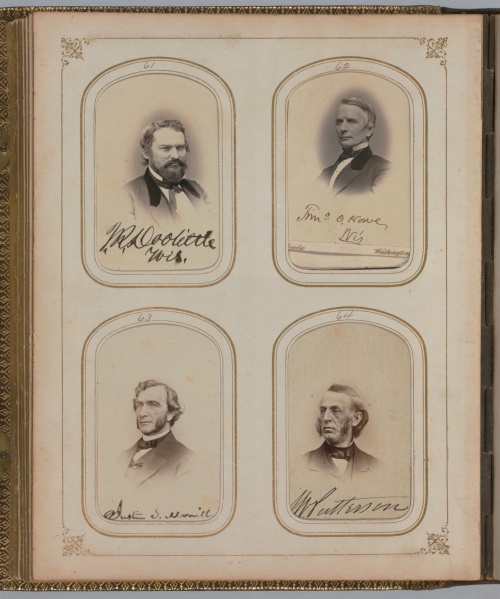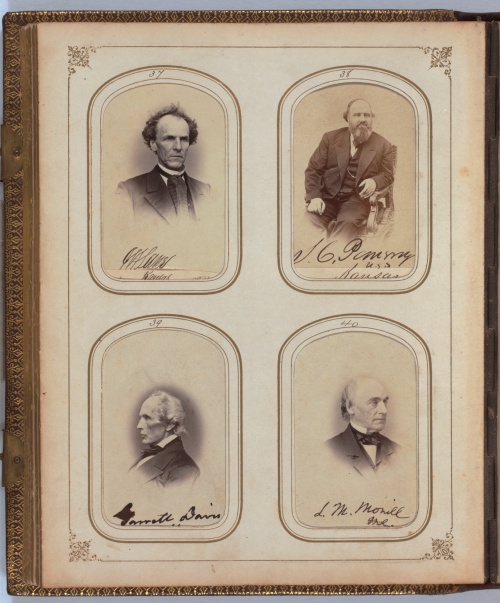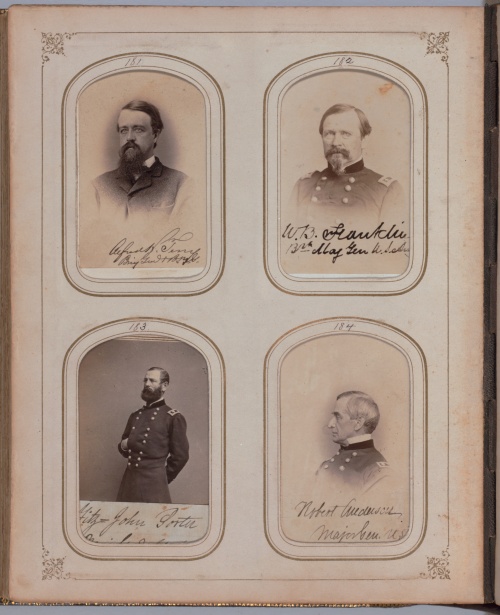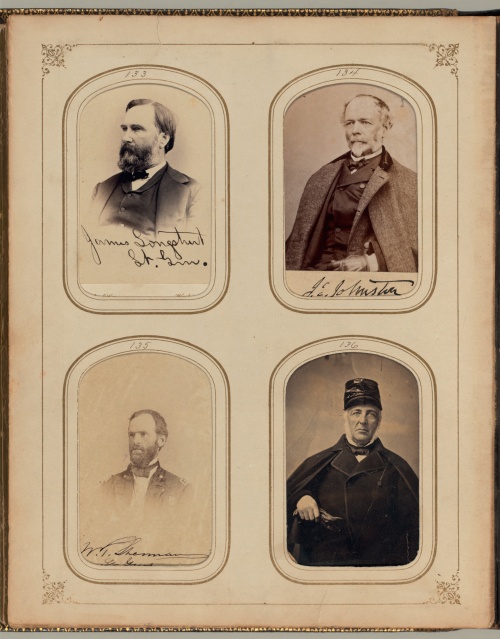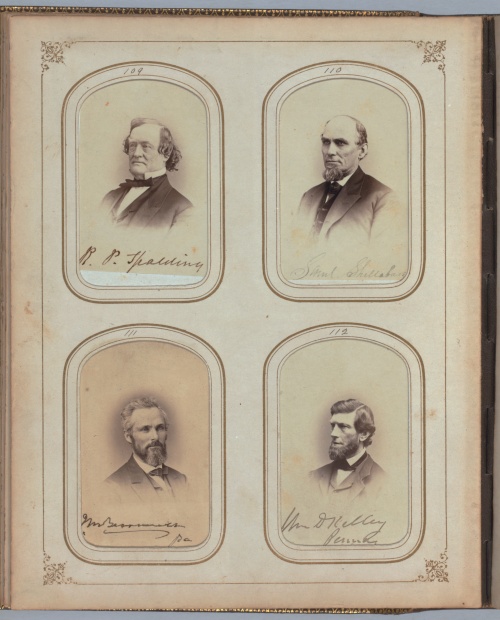Civil War photograph album, ca. 1861-65 (James Wadsworth Family Papers) (55 photos)
Cartes de visite, miniature portraits used as business cards, were extremely popular during the American Civil War. Measuring approximately 2½ x 4 inches, these photographic business cards were invented in France in the early 1850s, and their popularity quickly spread throughout Europe and eventually to the United States, where the subsequent development of the photo album stimulated a collecting craze. The 1860s, which became known as “Cartomania.”1 In addition to creating albums of family photographs, the public sought to collect images of celebrities and views of favorite places and landmarks. It is believed that John Hay (1838-1905), personal secretary to President Abraham Lincoln (1809-1865), who later had a successful diplomatic and political career, collected the cards in this album. Many of the two hundred people featured in Hay's album, including numerous army and navy officers, politicians, and cultural figures, were undoubtedly guests of Lincoln's White House. Others, such as Confederate President Jefferson Davis (1808–1889) and Generals Robert E. Lee (1807–1870) and James Longstreet (1821–1904), were unlikely to enter the President's mansion.
Most of the portraits in Hay's album are signed, which greatly increases their value. During the war, it was common practice to acquire such portraits as gifts or purchases, mail them to the persons introduced, and hope for their return with a signature. Thus, on the back of many cards there are notes asking the sitter to place his signature at the bottom of the card, high enough to be visible in the album. It was also common for many photographers, including Matthew B. Brady (1823–1896) and Alexander Gardner (1821–1882), whose work is well documented in this album, to keep stocks of autograph cards for sale to souvenir album collectors. Hay knew both Brady and Gardner, and went with Lincoln to the latter's studio to meet with the president and separately to take photographs. It is possible that he purchased cards from Gardner and others in addition to those he acquired directly from the sitters.
Hay carefully organized his map collection in a decorative leather-bound album patented by Altemus & Company of Philadelphia on July 21, 1863. Like many such albums, this one has gold stamped decoration on the cover and spine, as well as engraved ivory roundels on each corner of the cover and two brass clasps. The text block consists of a title page, a blank index page, twenty-five landscape pages, and a rear endpaper. Each album page contains eight cards - four on the front and four on the back, inserted into recessed pockets. Because the cards were arranged one after another in the album, sometimes the ink instructions for one sitter would bleed from the back of one card to the back of another. The edges of the text block are gold plated, as are the edges of the holes for each photo. The holes are numbered from 1 to 200, perhaps by the same hand that wrote on the first page: “Do not touch the images with your fingers.” Of particular interest to book restorers is the album's "hinged" spine, ingeniously designed to allow flexible movement of a heavy text block with rigid pages. The album pages are attached to the spine with slotted leather loops and inserted metal pins. Each pin alternately picks up the loops of the page from the front and back, forming a continuous attachment of the leaves. When the pages are turned, they rotate on the pin.
This digital reproduction of the album gives viewers the opportunity to flip through the cards as if they were looking through the volume in Hay's home. These "album page views" allow readers to appreciate the selection and arrangement of Hay's photographs. For example, Hay began the album with Lincoln, followed by his vice presidents and members of his cabinet. Elsewhere in the album there are groups of politicians and military men, and at the end of the book there are images of cultural and literary figures. By selecting the "View These Maps" option on any album page, readers can see the images as they would appear outside of the album. Both the front and back of each card are fully displayed, displaying studio logos, addresses, and other information about the approximately twenty photographers and/or photography firms featured in the album. One particularly elaborate print is for the studio of Alexander Gardner, depicting the United States Capitol and its grounds, as well as figures strolling along the esplanade.
Hay's album became the property of the Wadsworth family through Hay's daughter Alice, who married James Wadsworth Jr. It was subsequently donated to the library as part of the Wadsworth family papers.
